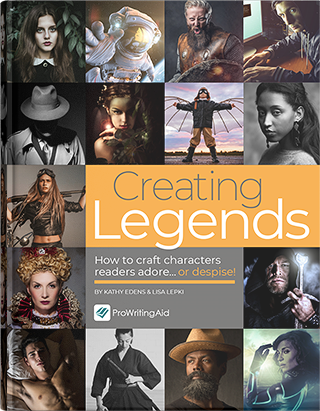
When we meet someone for the first time, we know they didn’t pop into existence the moment we met them. Maybe they got food poisoning when they were 10, or visited Costa Rica on their honeymoon, or earned a graduate degree in existential philosophy from a school you’ve never heard of. Whatever it is, it’s all backstory.
Just like any living person, fictional characters need backstory, too. So what are some ways to develop it? We’ll examine several options in this article.
Establish Backstory, but Reveal It Strategically
Yes, every character needs a backstory. But it doesn't need revealing immediately or entirely. Imagine meeting a stranger, and the first thing they say is: “Hi, I’m George. When I was five, I almost drowned in a pool, so now I have a fear of swimming. What’s your name?”
When people introduce themselves, they naturally start with their present situation. Then, only when it’s logical to do so, they reveal details of their past. Most characters should behave similarly. We should discover character backstory only when it’s natural and necessary.
For example, I wrote a novella in which the main character is missing three fingers from his right hand. This detail is clearly established in the second scene, yet the reader doesn’t immediately know where his fingers went. Only later in the story, when the main character and his partner venture into a creepy forest, does he reveal what happened: he lost his fingers to frostbite after getting lost in that very forest! The timing felt right to reveal that bit of backstory.
In some cases, you might devise character backstory without ever directly revealing it. You’ve probably heard of writers who write biographies on their characters, yet never address all that history directly in the text. This strategy can add depth to a character without making your text unwieldy. Sometimes, only you need to know.
Take things on a case-by-case basis. Figure out what your story needs in the moment, then decide whether or not revealing backstory is the way to achieve it.
Connect Backstory with Motivation
Like most of the world right now, you’re probably spending much of your day at home. If so, you might be watching more TV than usual. In the case of me and my wife, we’re watching my favorite show ever: The X-Files.
The X Files does an excellent job connecting the protagonists’ backstories with their current motivation. For example, Agent Fox Mulder witnessed his sister’s abduction by aliens. This event drives him to seek truth in the present, even when it’s otherworldly.
Likewise, Mulder’s counterpart, Dana Scully, has a background in medicine, earning years of experience in the field of science. Therefore, she seeks truth in rationality. Her history provides a pleasing counterpoint to Mulder’s; Scully believes in scientific explanations, while Mulder believes in pretty much anything. It’s an excellent example of the past affecting the present.
Why is this important? Because fictional characters should emulate real-life human beings, and we’re all shaped by our experiences. If a character’s past doesn’t reveal something relevant about them, it’s not just unrealistic—it’s purposeless.
I’ll give you an example. The other day, my wife and I watched one of the Twilight movies with friends over Zoom (don’t ask). No offense to the author and the people who worked on this film, but I found it mostly unwatchable. One reason: the flashbacks.
I went to bed before the movie ended, but in the brief time I watched, I counted three different character flashbacks. Great, we got some backstory. The problem? None of it was relevant.
For example, one character describes being a soldier for the Southern army in the American Civil War. He discovers three women standing near a lake—never explained what they’re doing there—and then they bite him.
In a literal sense, I guess we learned how he became a vampire. However, that knowledge doesn’t add insight into the character. It’s backstory, yes. But it’s backstory without a purpose.
Avoid Information Dumps

As in the Twilight films, you might use a simple flashback scene (just do it better than they did). It’s an eternal technique, and one that works fairly well, so long as you time it right. A character might also reveal their own backstory, given justifiable prompting. Whatever method you choose, it need not all come out at once.
Let’s use a character from George R.R. Martin’s epic fantasy series A Song of Ice and Fire as an example. You’re probably familiar with Tyrion Lannister, the clever and dryly humorous heir to Casterly Rock. Here’s one of the very first descriptions of him:
“Tyrion Lannister, the youngest of Lord Tywin's brood, and by far the ugliest. All that the gods had given to Cersei and Jaime, they had denied Tyrion. He was a dwarf, half his brother's height, struggling to keep pace on stunted legs. His head was too large for his body, with a brute's squashed-in face beneath a swollen shelf of brow. One green eye and one black one peered out from under a lank fall of hair so blond it seemed white.”
On its face, this is a physical description. But it’s also a subtle hint at backstory. Tyrion’s physical differences between himself and his siblings is a conflict from their past that affects their present.
Furthermore, we get additional backstory about Tyrion throughout the series, though not all at once. Later on, we learn one of my favorite bits of backstory about Tyrion:
“So to mark his manhood, Tyrion was given charge of all the drains and cisterns within Casterly Rock. Perhaps he hoped I’d fall into one. But Tywin had been disappointed in that. The drains never drained half so well as when he had charge of them.”
This backstory shows us that when Tyrion cares about a job, he’ll do it well, even if it isn’t particularly glamorous.
The lesson here is to avoid infodumping. That’s when a writer elaborates on a subject so much that the story stalls. If Martin had crammed both these bits of backstory into Tyrion’s introduction, imagine how dull it would’ve been. Instead, he reveals them gradually—several books apart, in fact.
This is going to sound contradictory, but the best way to avoid infodumping is to allow yourself to infodump. Write a character’s entire backstory in your first draft. Then in subsequent drafts, extract bits of that backstory and insert them where appropriate. You might find some backstory doesn’t fit anywhere, in which case it’s best to cut it. It’s painful, I know, but your awareness of it will add depth to your character.
Backstory Bonus Tip
As a bonus tip, I’ve got a simple suggestion: consume more stories! Read books, watch movies, listen to audio productions. Every great story has backstory, so pay attention to how other storytellers do it, then apply their technique to your work. I hope this gets you off to a good start!


